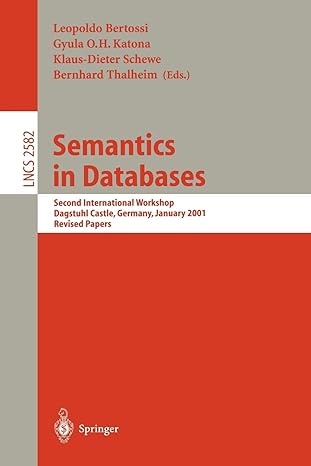Question
1. Fill in the fuction N= myNull (A) to create a matrix N whose columns are the homogeneous solutions (i.e. elements of the null space
1. Fill in the fuction N= myNull (A) to create a matrix N whose columns are the homogeneous solutions (i.e. elements of the null space of A). The output of your fuction should match that of Matlab`s build-in function, N =null (A,'r'). Note that this uses the optional second input 'r'.
Hind:
function [ N ] = myNull( A )%myNull Find the null space of A
% The elimination matrix E is defined so that the entry in row i and
% column j of E*A is 0.
% Inputs:
% A - input A matrix
% Outputs:
% N - matrix whose columns are the null space vectors
% You can double check your answer by comparing it to Matlab's built-in function.
% myNull(A) should be the same as null(A, 'r')
% Also, recall the definition of the null space. If you do A * N you% should get a matrix of 0's. Think about why this is![R, c_pivot] = rref(A);
% Put A into reduced row echelon form and output the list of pivot columns
% recall, c_pivot(3) is the column containing the 3rd pivotrk = rank(R);
% rank of R (or A)[m, n] = size(R);
% size of R (or A), where m is the number of rows and n the number of columnsN = zeros(n, n-rk);
% initialize N matrix to be the appropriate sizec_free = 1:n;
% create a list of all columnsc_free(c_pivot) = [];
% remove the pivot columns from the list to get just a list of the free columns% ex. c_free(1) is the number of the first free column
%%%% YOUR CODE GOES HERE %%%%
%% For each free column, cf, find the corresponding homogeneous solution, xh
% Recall that the homogeneous solution has the following structure:
% -- The number 1 in the entry of xh corresponding to the free column
% ex. put 1 in xh(cf)
% -- The elements of the free column in R in the entries of xh corresponding to the pivot columns
% ex. put -R(i,cf) in xh(c_pivot(i))
% These xh's are stored in the columns of N
%%%% YOUR CODE ENDS HERE %%%%
end
2. Fill in the function x = myLeastSquares(A,b) to dinf the least squares solution to Ax = b. Remember that if a solution does exist, this will also be the least squares solution. The output of your function should match that of Matlab`s build - in command x = A\b.
Hint:
function x = myLeastSquares(A, b)
%myLeastSquares Solves the equation Ax = b when A has full column rank
% Inputs:
% A - matrix with full column rank
% b - column vector
% Outputs:
% x - column vector solving Ax = b in the least squares sense
% Check to make sure that A is full column rankif rank(A) < size(A,2)error('A is not full column rank');
%%%% YOUR CODE GOES HERE %%%%
%%%% YOUR CODE ENDS HERE %%%%
end
Even if professor gives hint...i don`t know what I have to do...please make code for those problems.
Step by Step Solution
There are 3 Steps involved in it
Step: 1

Get Instant Access to Expert-Tailored Solutions
See step-by-step solutions with expert insights and AI powered tools for academic success
Step: 2

Step: 3

Ace Your Homework with AI
Get the answers you need in no time with our AI-driven, step-by-step assistance
Get Started


